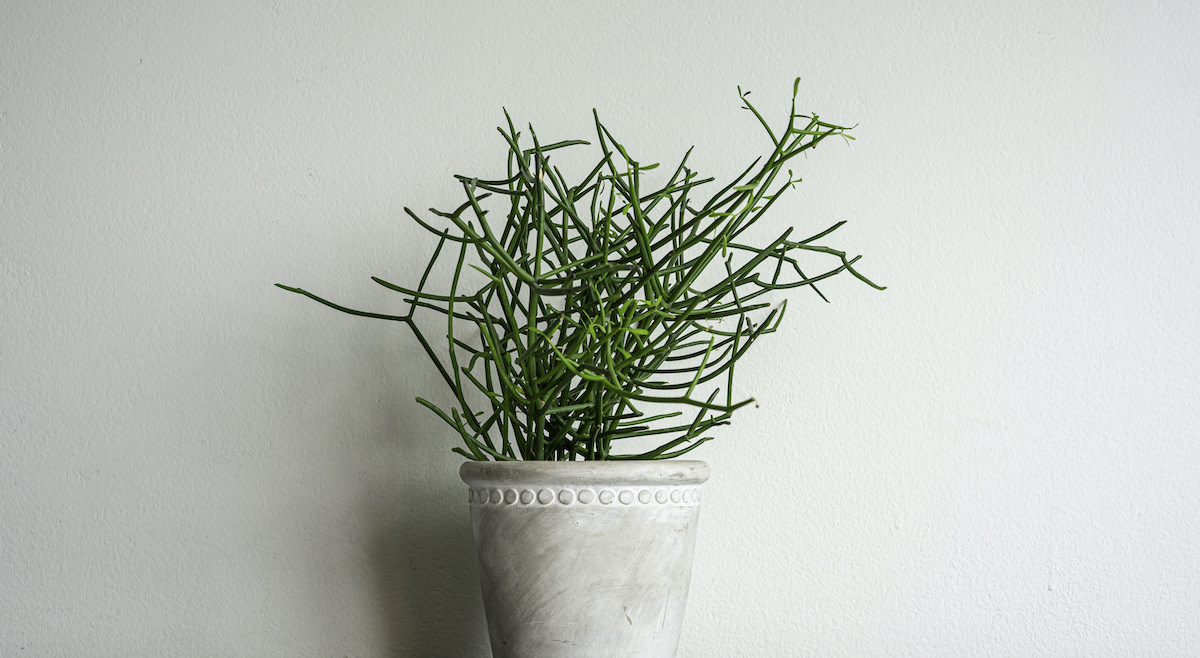Pencil Cactus Houseplant Guide: How to Care for Pencil Cactus
Written by MasterClass
Last updated: Jun 7, 2021 • 4 min read
Pencil cactus is a tall succulent with long, spindly branches. It makes for a good houseplant or ornamental garden succulent.
Learn From the Best
What Is a Pencil Cactus?
Contrary to its name, the pencil cactus (Euphorbia tirucalli) is a type of succulent, not a cactus plant. Native to South Africa and India, the pencil cactus is part of the Euphorbia genus. This succulent shrub features thick branches that split off into long, narrow stems that are about as thick as a pencil. In late spring and early summer, small yellow flowers grow at the end of the stems.
Other common names of the pencil cactus are milk bush, Indian tree spurge, pencil tree, and pencil plant. Some cultivars of the pencil cactus like ‘Sticks on Fire’ and ‘Rosea’—commonly known as firestick plant or fire plant—feature orange and red-colored stems. If grown outside, a pencil cactus can reach up to 30 feet tall and 10 feet wide. Indoors, a pencil cactus can grow up to six feet tall and three feet wide.
Is Pencil Cactus Toxic?
The pencil cactus contains a thick latex sap that is toxic to both humans and animals. When the milky sap touches skin, it can cause redness, rashes, burning, or other skin irritations. Take care to not get the sap in your eyes because it can cause irritation and even blindness. If ingested, the pencil cactus will cause vomiting and diarrhea. For some, the sap can cause anaphylaxis—a severe allergic reaction. Seek medical help if the sap comes into contact with eyes or skin. Keep the pencil cactus out of reach from children and pets.
How to Safely Handle a Pencil Cactus
If you need to touch a pencil cactus to either repot it, propagate it, or prune it, follow the safety tips below.
- Wear disposable gloves and eye protection. Wear goggles or glasses and a long-sleeved shirt and pants to minimize skin exposure and protect yourself from sap.
- Dispose of your gloves. After you handle the plant, remove and trash the disposable gloves. Check your clothes to see if any sap has landed on them before carefully removing.
- Wash your hands thoroughly after handling. Wash your hands with soap and water, especially if the sap has touched your skin. Do this quickly because once the sap is dried, it’ll be harder to remove.
How to Plant and Care for a Pencil Cactus
Pencil cacti are typically sold potted at garden centers. Follow these steps to plant and grow a pencil cactus:
- 1. Wear protective gear to handle the plant. The plant’s sap is toxic, so wear eye protection, disposable gloves, long sleeves, and pants to protect your eyes and skin from the plant.
- 2. Plant the pencil cactus in a pot with drainage. If you are planting a pencil cactus indoors, choose a terra cotta or clay pot with drainage holes. The clay will absorb the water from the soil, so the cactus isn’t sitting in wet soil, which isn’t good for it.
- 3. Plant the pencil cactus in well-draining, sandy soil. Whether you’re planting pencil cactus indoors or outdoors, make sure the soil is well-draining and sandy so that it will dry out easily. You can add loam to your garden soil to make it airier, and use a cactus or succulent mix soil indoors.
- 4. Let the soil dry out between waterings. During the growing season in the spring and summer, water your pencil cactus every two to three weeks. In the fall and winter, water only once a month. Overwatering can lead to root rot, and the stems will droop.
- 5. Find a spot that gets direct sunlight. The pencil cactus prefers full sun for at least six hours a day and low humidity. Indoors, place it by a south or west-facing window. It will not thrive in low-light conditions.
- 6. Keep the pencil cactus in a warm environment. Pencil cactus will not tolerate temperatures below 50 degrees Fahrenheit.
- 7. Prune the plant to encourage growth. Wear gloves and eye protection when handling the plant. Prune from the top to taper off the height and encourage bushier growth. You can also prune dead stems.
- 8. Give your pencil cactus room to grow. A pencil cactus should be repotted every one to two years, when its roots have outgrown the plant’s current vessel. Dig out the pencil cactus and trim off any roots that look dead, shriveled, black, or rotten, then place it in a new pot that is two to four inches wider in diameter with a cactus mix soil. Wait one week before watering the plant.
How to Propagate a Pencil Cactus
A pencil cactus can be easily propagated from cuttings. Follow these steps to create new growth from a pencil cactus:
- 1. Protect yourself. Wear eye protection, disposable gloves, long sleeves, and pants to protect your eyes and skin from the plant’s toxic sap.
- 2. Cut a six-inch-long stem. Cut a stem of the pencil cactus off at an angle.
- 3. Stop the flow of sap. Since the sap is toxic, wear gloves and be extra careful when handling cut ends. Dip the cutting in water or wrap the end in a towel to suppress the secretion of sap.
- 4. Dry out the cutting. Let the cutting dry out until it forms a callous over the cut end, which could take a month or longer.
- 5. Pot the cutting. Pot the cutting in succulent or cactus potting mix soil and do not water it for one week.
Learn More
Grow your own garden with Ron Finley, the self-described "Gangster Gardener." Get the MasterClass Annual Membership and learn how to cultivate fresh herbs and vegetables, keep your house plants alive, and use compost to make your community—and the world—a better place.
